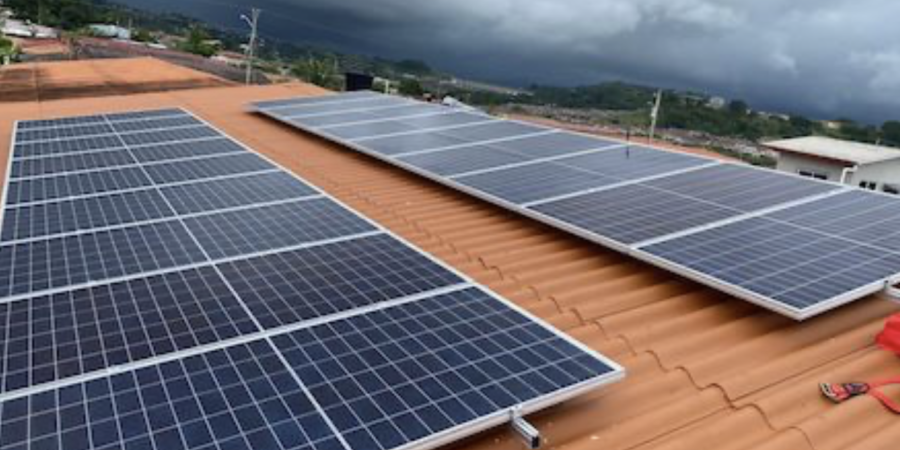Panama eliminates the selective consumption tax of the import tax and other levies on equipment for the construction, operation and maintenance of power plants and/or solar installations with Law 417 of December 27, 2023.
This was legalized and in force in the Official Gazette number No. 29938-A of December 27.
Rosilena Lindo, National Secretary of Energy, told SNIP News that already in Law 37, which was later modified by Law 38, the incentive regime for the promotion of the construction, operation and promotion of solar installations was established so that solar panels, mostly for self-consumption, did not have to pay the ITBMS and neither other levies and tariffs, however, the companies that were installing these equipment had to pay the selective consumption tax that represents 5% of the total cost of the value of the introduction to Panama.
This law was approved by the National Assembly of Panama a few weeks ago, but it was not until now that it was sanctioned and promulgated, which made it the law of the Republic.
“With this law in force, the percentage of benefits received by companies and people who import these equipment into Panama is even higher,” said Lindo.
Rising figures
The goal is to install more sunroofs, something that has been achieved according to the numbers mentioned by the energy secretary. They are betting that by 2030 14% of the total energy generated in Panama will come from solar roofs.
The information they handle in the entity indicates that every year the increase in the companies and people who install these equipments grows. In November 2022, there were 67.4 megawatts installed on solar roofs, twelve months later the figure increased to 91.8 megawatts. This is an increase of 36.2%.
The total number in Panama is 2,883 people and businesses that have installed solar panels on their roofs. A number that increased by 40% in a single year, according to Lindo.
In terms of procedures, on average monthly the National Secretariat approved 42 certifications for exemptions from levies and ITBMS, but in December, before approving Law 417, they reached 65 procedures. They expect that in the next three months the same amount of megawatts will be installed as they were installed in 2023, which is about 30 additional megawatts.
“Every day more people are installing their solar system, generating and consuming clean energy, and the impact of this law will make it easier for that final consumer to acquire these equipment at a lower price. This is part of the measures that the State is pushing to address the impact of the child phenomenon as a palliative,” said the official.
He added that they are being installed in many residences in the city and that the numbers are showing that it is the middle-class Panamanian who are betting heavily on solar energy.
The provinces with the highest number of photovoltaic solar systems are Panama, West Panama, Coclé, Chiriquí (especially David) and Los Santos.
“It should be noted that everything that is the dry arc has a very important potential because the greatest amount of solar irradiance in the country is in that area and also the least amount of cloudiness,” he said.
Financing
About 16 banks in the Panamanian square received training on photovoltaic solar energy and at least six have specific mechanisms to finance solar systems for the population “at a good price,” including the Savings Bank, as explained by the official.
“This law that has just been approved (Law 417) will help the profitability of the return on investment to be even faster and that the Panamanian can enjoy less expensive and even cleaner energy,” he said.
As for whether this is accessible to the population, he said yes and now he went down, but he clarified that it depends on the consumption of the household.
“If you are a home where between 300 and 400 kilowatts per hour is consumed, you have a manageable price that can be financed at 5 years, as if you were buying a car, but if you are a house that consumes more electricity such as 700 or more kilowatts per hour, the installation is more expensive because you need the installation of more equipment, but the decrease in the bill makes the repayment process in a similar or shorter time.”
Solar Single Window
The National Secretary of Energy is working on the improvement in the tramitology they will be creating a platform for the unification of permissionology for distributed generation or self-consumption or solar roofs.
This platform will have the solar single window so that the processes are shorter and to unify prices that are paid Municipalities, firefighters and inspections and in this way be able to install the most expeditious systems and with prices in the permits that reflect the sizes of the system in a unison.
This project is being done with the Inter-American Development Bank (IDB) and the Government Innovation Authority (IGA)
They will launch the first pilot in mid-May 2024, Rosilena Lindo told SNIP Noticias, National Energy Secretary of Panama.
Experience
A user told this media that his experience with the installation of solar panels in his residence has been good. It has been two years since its installation. Although he clarified that the recovery of the investment can be longer and even more so if they decide to add batteries. An average of 1000kw with batteries can be about US$17,000 in investment.
